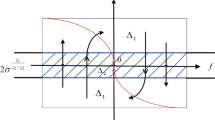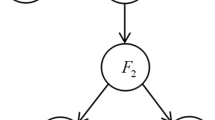Abstract
This paper studies the prescribed performance tracking problem for nonlinear leader-following multiagent systems by developing a data-driven cooperative adaptive sliding mode controller. First, the synchronization measurement error is transformed by combining prescribed performance function with sliding mode surface. Then, the agent’s dynamics are described as a linearization model by the pseudo-partial derivative, and a data-based cooperative adaptive sliding mode control approach is designed to achieve the synchronization of all agents. The synchronization measurement error can converge to the predefined zone. Moreover, the proposed controller only depends on the input/output data of the agents. The effectiveness and advantages of the proposed controller are verified by numerical simulations.











Similar content being viewed by others
Data Availability Statement
Data sharing is not applicable to this article as no datasets were generated or analyzed during the current study.
References
Areak, M.: In: American Control Conference, pp. 29–34 (2006)
Giuseppe, B., Filippo, F., Franco, B., Sergio, G.: On the convergence of discrete-time linear systems: A linear time-varying mann iteration converges iff the operator is strictly pseudocontractive. IEEE Control Systems Letters 2(3), 453 (2018)
Olfati-Saber, R., Murray, R.M.: Consensus problems in networks of agents with switching topology and time-delays. IEEE Trans. Autom. Control 49(9), 1520 (2004)
Deplano, D., Franceschelli, M., Giua, A.: A nonlinear Perron-Frobenius approach for stability and consensus of discrete-time multi-agent systems. Automatica 118, 109025 (2020)
Ghasemi, K., Ghaisari, J., Abdollahi, F.: Robust formation control of multiagent systems on the lie group se(3). Int. J. Robust Nonlinear Control 30(3), 966 (2020). https://doi.org/10.1002/rnc.4806
Yan, M., Ma, W., Zuo, L., Yang, P.: Dual-mode distributed model predictive control for platooning of connected vehicles with nonlinear dynamics. Int. J. Control Autom. Syst. 17(12), 3091 (2019)
Gao, S., Dong, H., Ning, B.: Neural adaptive dynamic surface control for uncertain strict-feedback nonlinear systems with nonlinear output and virtual feedback errors. Nonlinear Dyn. 90(4), 1 (2017)
Song, J., Yan, M., Yang, P.: Neural adaptive dynamic surface asymptotic tracking control for a class of uncertain nonlinear system. Signal Process, Circuits Syst. (2020). https://doi.org/10.1007/s00034-020-01558-9
Polyakov, A.: Sliding mode control design using canonical homogeneous norm. Int. J. Robust Nonlinear Control 29(3), 682 (2019). https://doi.org/10.1002/rnc.4058
Song, J., Yan, M., Ju, Y., Yang, P.: Nonlinear gain feedback adaptive DSC for a class of uncertain nonlinear systems with asymptotic output tracking. Nonlinear Dyn. 98(3), 2195 (2019)
Bechlioulis, C.P., Rovithakis, G.A.: Decentralized robust synchronization of unknown high order nonlinear multi-agent systems with prescribed transient and steady state performance. IEEE Trans. Autom. Control 62(1), 123 (2017)
Knorn, S., Chen, Z., Middleton, R.: Overview: collective control of multiagent systems. IEEE Trans. Control Netw. Syst. 3(4), 334 (2016)
Li, Z., Ren, W., Liu, X., Fu, M.: Consensus of multi-agent systems with general linear and Lipschitz nonlinear dynamics using distributed adaptive protocols. IEEE Trans. Autom. Control 58(7), 1786 (2013)
Wang, Q., Wang, J.L., Wu, H.N., Huang, T.: Consensus and \(h_{\infty }\) consensus of nonlinear second-order multi-agent systems. IEEE Trans. Netw. Sci. Eng. 7(3), 1251 (2020). https://doi.org/10.1109/TNSE.2019.2917287
Ren, S.Y., Wang, Q., Wang, J.L.: Passivity-based finite-time synchronization of nonlinear multi-agent systems. IEEE Trans. Netw. Sci. Eng. 7(3), 1953 (2020). https://doi.org/10.1109/TNSE.2019.2963465
Cao, L., Zheng, Y., Zhou, Q.: A necessary and sufficient condition for consensus of continuous-time agents over undirected time-varying networks. IEEE Trans. Autom. Control 56(8), 1915 (2011)
Wang, A., Mu, B., Shi, Y.: Event-triggered consensus control for multiagent systems with time-varying communication and event-detecting delays. IEEE Trans. Control Syst. Technol. 27(2), 507 (2019)
Ji, H., Hou, Z., Fan, L., Lewis, F.L.: Adaptive iterative learning reliable control for a class of non-linearly parameterised systems with unknown state delays and input saturation. IET Control Theory Appl. 10(17), 2160 (2016)
Yu, M., Li, C.: Robust adaptive iterative learning control for discrete-time nonlinear systems with time-iteration-varying parameters. IEEE Trans. Syst., Man, Cybern., Syst. 47(7), 1737 (2017)
Heong Ang, Kiam, Chong, G., Li, Yun: Pid control system analysis, design, and technology. IEEE Trans. Control Syst. Technol. 13(4), 559 (2005)
Hou, Z., Wang, Z.: From model-based control to data-driven control: Survey, classification and perspective. Inf. Sci. 235(Complete), 3 (2013)
Karimi, A., Gorka, G.: Fixed-order \(h_\infty \) controller design for nonparametric models by convex optimization. Automatica 46(8), 1388 (2010)
Hou, Z.: The parameter identification, adaptive control and model free learning adaptive control for nonlinear systems (1994)
Hou, Z., Liu, S., Yin, C.: Local learning-based model-free adaptive predictive control for adjustment of oxygen concentration in syngas manufacturing industry. IET Control Theory Applications 10(12), 1384 (2016)
Hou, Z., Liu, S., Tian, T.: Lazy-learning-based data-driven model-free adaptive predictive control for a class of discrete-time nonlinear systems. IEEE Trans. Neural Netw. Learn. Syst. 28(8), 1914 (2017)
Weng, Y., Gao, X.: Data-driven robust output tracking control for gas collector pressure system of coke ovens. IEEE Trans. Ind. Electron. 64(5), 4187 (2017)
N.M. Linh, X. Chen. In 2016 14th International Conference on Control, Automation, Robotics and Vision (ICARCV) (2016), pp. 1–6
Nguyen, M.L., Chen, X., Yang, F.: Discrete-time quasi-sliding-mode control with prescribed performance function and its application to piezo-actuated positioning systems. IEEE Trans. Industr. Electron. 65(1), 942 (2018)
Chidentree, T.: Varying-sliding condition adaptive controller for a class of unknown discrete-time systems with data-driven model. Int. J. Model. Ident. Control 27(3), 210 (2017)
Wang, Z., Liu, L., Zhang, H.: Neural network-based model-free adaptive fault-tolerant control for discrete-time nonlinear systems with sensor fault. IEEE Trans. Syst., Man, Cybern., Syst. 47(8), 2351 (2017)
Pang, Z., Liu, G., Zhou, D., Sun, D.: Data-driven control with input design-based data dropout compensation for networked nonlinear systems. IEEE Trans. Control Syst. Technol. 25(2), 628 (2017)
Bu, X., Hou, Z., Zhang, H.: Data-driven multiagent systems consensus tracking using model free adaptive control. IEEE Trans. Neural Netw. Learn. Syst. 29(5), 1514 (2018)
Bechlioulis, C.P., Rovithakis, G.A.: Robust adaptive control of feedback linearizable mimo nonlinear systems with prescribed performance. IEEE Trans. Autom. Control 53(9), 2090 (2008)
Bechlioulis, C.P., Rovithakis, G.A.: Prescribed performance adaptive control for multi-input multi-output affine in the control nonlinear systems. IEEE Trans. Autom. Control 55(5), 1220 (2010)
Jia, F., Wang, X., Zhou, X.: Robust adaptive prescribed performance control for a class of nonlinear pure-feedback systems. Int. J. Robust Nonlinear Control 29(12), 3971 (2019). https://doi.org/10.1002/rnc.4592
Dong, H., Gao, S., Ning, B., Tang, T., Li, Y., Valavanis, K.P.: Error-driven nonlinear feedback design for fuzzy adaptive dynamic surface control of nonlinear systems with prescribed tracking performance. IEEE Trans. Syst. Man Cybern. Syst. 50(3), 1013 (2020)
Liu, H., Li, X., Liu, X., Wang, H.: Adaptive neural network prescribed performance bounded- \(h_{\infty }\) tracking control for a class of stochastic nonlinear systems. IEEE Trans. Neural Netw. Learn. Syst. 31(6), 2140 (2020)
Du, P., Zhou, Q., Liang, H.: Neural adaptive prescribed performance control for interconnected nonlinear systems with output dead zone. Int. J. Robust Nonlinear Control 30(3), 999 (2020). https://doi.org/10.1002/rnc.4802
Zhang, J., Yang, G.: Adaptive prescribed performance control of nonlinear output-feedback systems with unknown control direction. Int. J. Robust Nonlinear Control 28(16), 4696 (2018). https://doi.org/10.1002/rnc.4277
Bai, W., Wang, H.: Robust adaptive fault-tolerant tracking control for a class of high-order nonlinear system with finite-time prescribed performance. Int. J. Robust Nonlinear Control 30(12), 4708 (2020). https://doi.org/10.1002/rnc.5018
El-Ferik, S., Hashim, H.A., Lewis, F.L.: Neuro-adaptive distributed control with prescribed performance for the synchronization of unknown nonlinear networked systems. IEEE Trans. Syst., Man, Cybern., Syst. 48(12), 2135 (2018)
Shen, Q., Shi, P., Zhu, J., Wang, S., Shi, Y.: Neural networks-based distributed adaptive control of nonlinear multiagent systems. IEEE Trans. Neural Netw. Learn. Syst. 31(3), 1010 (2020)
Wang, W., Liang, H., Pan, Y., Li, T.: Prescribed performance adaptive fuzzy containment control for nonlinear multiagent systems using disturbance observer. IEEE Trans. Cybern. 50(9), 3879 (2020)
Liu, Y., Yang, G.: Prescribed performance-based consensus of nonlinear multiagent systems with unknown control directions and switching networks. IEEE Trans. Syst., Man, Cybern., Syst. 50(2), 609 (2020)
Chen, K., Wang, J., Zhang, Y., Liu, Z.: Leader-following consensus for a class of nonlinear strick-feedback multiagent systems with state time-delays. IEEE Trans. Syst. Man Cybern. Syst. 50(7), 2351 (2020). https://doi.org/10.1109/TSMC.2018.2813399
Liu, D., Yang, G.: Data-driven adaptive sliding mode control of nonlinear discrete-time systems with prescribed performance. IEEE Trans. Syst. Man Cybern. Syst. 49(12), 2598 (2019)
Author information
Authors and Affiliations
Corresponding author
Ethics declarations
Conflict of interest
The authors declared that they have no conflict of interest.
Additional information
Publisher's Note
Springer Nature remains neutral with regard to jurisdictional claims in published maps and institutional affiliations.
Appendix
Appendix
Proofs of Theorem 1
Proof
Substituting (43) into (41), we have
where
where \(\mathfrak {M}_i = \frac{ \hat{\theta }_i(k)^2 }{\gamma _i + \hat{\theta }_i(k)^2 } < 1\).
If \(s_i(k) < 0\), we have
Leveraging (44), we have
Then,
If \(s_i(k) > 0\), we have
Then,
Define \(\varOmega _i\) as a bounded function
Case A \(s_i(k)\) out of the region \(\varOmega _i\):
or
Using (49) and (50), step size \(\triangle s_i(k) < \varOmega _i\) will make the sliding surface \(s_i(k)\) reach and enter \(\varOmega _i\).
Case B \(s_i(k)\) gets into the region \(\varOmega _i\):
In this case,
1) If \(0>s_i(k) > \frac{1}{2} \ln \bigg ( \frac{\varPsi _{i,a}(k) - 2 \varPsi _{i,b}(k) \varGamma _i}{\varPsi _{i,a}(k) + 2 \varPsi _{i,c}(k) \varGamma _i} \bigg ) \), we have
Due to \(\varGamma _i > |\mathfrak {N}_{i,a} |\), we have
2) If \(0< s_i(k) < \frac{1}{2} \ln \bigg ( \frac{\varPsi _{i,a}(k) + 2 \varPsi _{i,b}(k) \varGamma _i}{\varPsi _{i,a}(k) - 2 \varPsi _{i,c}(k) \varGamma _i} \bigg ) \), we have
Due to \(\varGamma _i > | N_{i,a}(k) |\), we have
Thus, we conclude that the \(s_i(k)\) is bounded. According to (32), \(\varsigma _i(k)\) is bounded, which implies that \(z_i(k)\) is bounded. According to Lemma 1, \(e_i(k)\) is bounded. And \(e_i(k)\) is constrained by the modified condition (11), which means the prescribed performance is guaranteed.
This completes the proof. \(\square \)
Rights and permissions
About this article
Cite this article
Zhang, Y., Song, J. Nonlinear leader-following MASs control: a data-driven adaptive sliding mode approach with prescribed performance. Nonlinear Dyn 108, 349–361 (2022). https://doi.org/10.1007/s11071-022-07218-8
Received:
Accepted:
Published:
Issue Date:
DOI: https://doi.org/10.1007/s11071-022-07218-8




